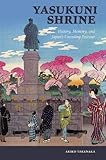Yasukuni Shrine : History, Memory, and Japan's Unending Postwar / Akiko Takenaka.
Material type: TextSeries: Studies of the Weatherhead East Asian Institute, Columbia UniversityPublisher: Honolulu : University of Hawaii Press, [2015]Copyright date: ©2015Description: 1 online resource (296 p.) : 10 black & white illustrationsContent type:
TextSeries: Studies of the Weatherhead East Asian Institute, Columbia UniversityPublisher: Honolulu : University of Hawaii Press, [2015]Copyright date: ©2015Description: 1 online resource (296 p.) : 10 black & white illustrationsContent type: - 9780824846787
- 9780824856939
- 299.5/61350952135 23
- BL2225.T62T35 2015
- online - DeGruyter
- Issued also in print.
| Item type | Current library | Call number | URL | Status | Notes | Barcode | |
|---|---|---|---|---|---|---|---|
 eBook
eBook
|
Biblioteca "Angelicum" Pont. Univ. S.Tommaso d'Aquino Nuvola online | online - DeGruyter (Browse shelf(Opens below)) | Online access | Not for loan (Accesso limitato) | Accesso per gli utenti autorizzati / Access for authorized users | (dgr)9780824856939 |
Browsing Biblioteca "Angelicum" Pont. Univ. S.Tommaso d'Aquino shelves, Shelving location: Nuvola online Close shelf browser (Hides shelf browser)

|

|

|

|

|

|

|
||
| online - DeGruyter Writers of the Winter Republic : Literature and Resistance in Park Chung Hee's Korea / | online - DeGruyter City of Marvel and Transformation : Changan and Narratives of Experience in Tang Dynasty China / | online - DeGruyter Lovable Losers : The Heike in Action and Memory / | online - DeGruyter Yasukuni Shrine : History, Memory, and Japan's Unending Postwar / | online - DeGruyter Oedipal God : The Chinese Nezha and His Indian Origins / | online - DeGruyter Forging Islamic Power and Place : The Legacy of Shaykh Daud bin 'Abd Allah al-Fatani in Mecca and Southeast Asia / | online - DeGruyter The Fluid Pantheon : Gods of Medieval Japan, Volume 1 / |
Frontmatter -- Contents -- Acknowledgments -- Introduction -- One. Mobilizing Death: Developing the Myth of Yasukuni -- Two. Institutionalizing Joy: Turning War into Spectacle at Yasukuni Shrine -- Threee. Networks of Grief and Pride: Yasukuni Shrine in Regional Japan -- Four. Institutionalizing Grief: Yasukuni Shrine and Total War -- Five. Who Has the Right to Mourn? Politics of Enshrinement at Yasukuni Shrine -- Six. Mobilizing Memories: Postmemorial Conservatism at Yasukuni Today -- Epilogue Contesting Memories: Yasukuni Shrine as a Countermonument -- Notes -- Bibliography -- Index
restricted access online access with authorization star
http://purl.org/coar/access_right/c_16ec
This is the first extensive English-language study of Yasukuni Shrine as a war memorial. It explores the controversial shrine's role in waging war, promoting peace, honoring the dead, and, in particular, building Japan's modern national identity. It traces Yasukuni's history from its conceptualization in the final years of the Tokugawa period and Japan's wars of imperialism to the present. Author Akiko Takenaka departs from existing scholarship on Yasukuni by considering various themes important to the study of war and its legacies through a chronological and thematic survey of the shrine, emphasizing the spatial practices that took place both at the shrine and at regional sites associated with it over the last 150 years. Rather than treat Yasukuni as a single, unchanging ideological entity, she takes into account the social and political milieu, maps out gradual transformations in both its events and rituals, and explicates the ideas that the shrine symbolizes. Takenaka illuminates the ways the shrine's spaces were used during wartime, most notably in her reconstructions, based on primary sources, of visits by war-bereaved military families to the shrine during the Asia-Pacific War. She also traces important episodes in Yasukuni's postwar history, including the filing of lawsuits against the shrine and recent attempts to reinvent it for the twenty-first century. Through a careful analysis of the shrine's history over one and a half centuries, her work views the making and unmaking of a modern militaristic Japan through the lens of Yasukuni Shrine. Yasukuni Shrine: History, Memory, and Japan's Unending Postwar is a skilled and innovative examination of modern and contemporary Japan's engagement with the critical issues of war, empire, and memory. It will be of particular interest to readers of Japanese history and culture as well as those who follow current affairs and foreign relations in East Asia. Its discussion of spatial practices in the life of monuments and the political use of images, media, and museum exhibits will find a welcome audience among those engaged in memory, visual culture, and media studies.
Issued also in print.
Mode of access: Internet via World Wide Web.
In English.
Description based on online resource; title from PDF title page (publisher's Web site, viewed 02. Mrz 2022)


